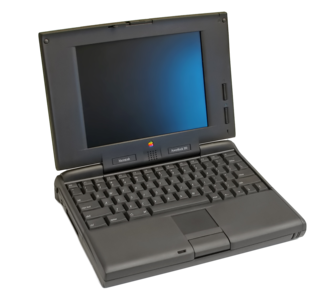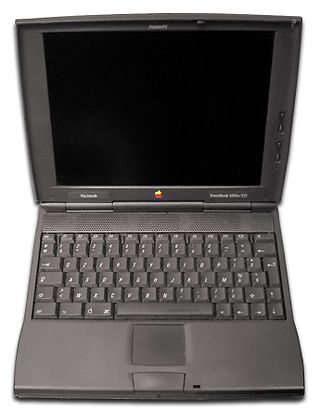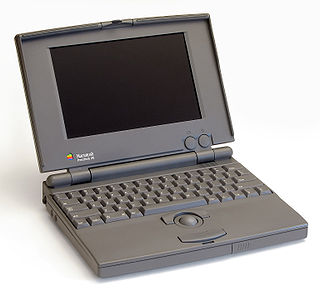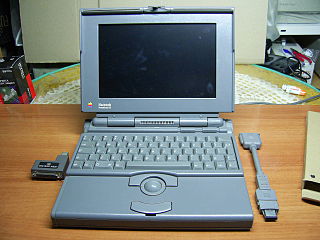
The PowerBook is a family of Macintosh laptop computers designed, manufactured and sold by Apple Computer from 1991 to 2006. During its lifetime, the PowerBook went through several major revisions and redesigns, often being the first to incorporate features that would later become standard in competing laptops. The PowerBook line was targeted at the professional market. In 1999, the line was supplemented by the home and education-focused iBook family.

The Apple IIe Card is a compatibility card, which through hardware and software emulation, allows certain Macintosh computers to run software designed for the Apple II series of computers. Released in March 1991 for use with the LC family, Apple targeted the card at its widely dominated educational market to ease the transition from Apple II-based classrooms, with thousands of entrenched educational software titles, to Macintosh-based classrooms.

The PowerBook Duo is a line of subnotebooks manufactured and sold by Apple Computer from 1992 until 1997 as a more compact companion to the PowerBook line. Improving upon the PowerBook 100's portability, the Duo came in seven different models. They were the Duo 210, 230, 250, 270c, 280, 280c, and 2300c, with the 210 and 230 being the earliest, and the 2300c being the final incarnation before the entire line was dropped in early 1997.

The PowerBook G3 is a series of laptop Macintosh personal computers designed, manufactured, and sold by Apple Computer from 1997 to 2001. It was the first laptop to use the PowerPC G3 (PPC740/750) series of microprocessors, and was marketed as the fastest laptop in the world for its entire production run. The PowerBook G3 was succeeded by the PowerBook G4.

The Macintosh Classic II is a personal computer designed and manufactured by Apple Computer, Inc. from October 1991 to September 1993. The system has a compact, appliance design with an integrated 9" monitor, typical of the earliest of the Macintosh range. A carrying handle moulded into the case added a degree of portability at a time when laptops were still relatively uncommon.

The Power Macintosh 6100 is a personal computer designed, manufactured and sold by Apple Computer from March 1994 to March 1996. It is the first computer from Apple to use the new PowerPC processor created by IBM and Motorola. The low-profile ("pizza-box") case was inherited from the Centris/Quadra 610 and 660AV models, and replaced the Macintosh Quadra series that used the Motorola 68040 processor, Apple's previous high-end workstation line.

The PowerBook 500 series is a range of Apple Macintosh PowerBook portable computers first introduced by Apple Computer with the 540c model on May 16, 1994. It was the first to have stereo speakers, a trackpad, and Ethernet networking built-in.
The Apple Network Server (ANS) was a line of PowerPC-based server computers designed, manufactured and sold by Apple Computer, Inc. from February 1996 to April 1997. It was codenamed "Shiner" and originally consisted of two models, the Network Server 500/132 and the Network Server 700/150, which got a companion model, the Network Server 700/200 with a faster CPU in November 1996.

The PowerBook 190 and its companion PowerBook 190cs are laptop computers manufactured by Apple Computer as part of their PowerBook brand, introduced to the market in August 1995. The two models differ only in their screen: the 190 had a 9.5" greyscale display, while the 190cs featured a 10.4" color display. Apple's target sales audience for this model was the college student in need of a no-frills portable computer.

The PowerBook 3400c is a laptop computer in the PowerBook line manufactured by Apple Computer from February to November 1997. It was briefly the fastest laptop in the world. Using the PowerPC 603e processor running at speeds of up to 240 MHz, this PowerBook was the first to feature a PCI architecture, EDO memory, and a 64-bit wide, 40 MHz internal bus. It was also the first PowerBook to feature a PC card slot capable of being used as a zoomed video port. Like all Apple laptops since the PowerBook 500 series, it featured a built-in trackpad as the pointing device.

The Power Macintosh 6200 is a series of personal computers designed, manufactured, and sold by Apple Computer from May 1995 to July 1997. The 6200 is the PowerPC-based replacement for the Quadra 630, with the same form factor and price range. In early 1997, the rather different Power Macintosh 6300/160 / Performa 6360 based on the Power Macintosh 6400 was introduced. The whole line was discontinued when the desktop model of the Power Macintosh G3 was released.

The PowerBook 1400 is a notebook computer that was designed and sold by Apple Computer, Inc. from 1996 to 1998 as part of their PowerBook series of Macintosh computers. Introduced in October 1996 at a starting price of $2,499, it was the first new PowerBook after the controversial PowerBook 5300. After the introduction of the more powerful PowerBook 3400c in February 1997, the 1400 took on the role of Apple's entry level notebook and remained there until its discontinuation in May 1998. Its successor, the PowerBook G3 Series, would ultimately go on to replace and consolidate not only the 1400, but the 2400c and 3400c as well.

The PowerBook 100 is a portable subnotebook personal computer designed and manufactured by Sony for Apple Computer and introduced on October 21, 1991, at the COMDEX computer expo in Las Vegas, Nevada. Priced at US$2,500 with external floppy drive, the PowerBook 100 was the low-end model of the first three simultaneously released PowerBooks. Its CPU and overall speed closely resembled those of its predecessor, the Macintosh Portable. It had a Motorola 68000 processor at 16 MHz, 2-8 megabytes (MB) of RAM, a 9-inch (23 cm) monochrome backlit liquid-crystal display (LCD) with 640 × 400 pixel resolution, and the System 7.0.1 operating system. It did not have a built-in floppy disk drive and was noted for its unique compact design that placed a trackball pointing device in front of the keyboard for ease of use.

The PowerBook 140 was released in the first line of PowerBooks. It was the mid-range PowerBook, between the low-end 100 and the high-end 170. As with the PowerBook 170, and unlike the 100, this PowerBook featured an internal floppy drive. Codenames for this model are: Tim Lite, Tim LC, Replacements, and Leary. In 1992, it was replaced by the PowerBook 145, which was essentially a speed bump, though the PowerBook 160 essentially superseded it as the new mid-line model.

The Power Macintosh 5500 is a personal computer designed, manufactured, and sold by Apple Computer from February 1997 to March 1998. Like the Power Macintosh 5260 and 5400 that preceded it, the 5500 is an all-in-one design, built around a PowerPC 603ev processor operating at 225, 250 or 275 megahertz (MHz).

The PowerBook 170 was released by Apple Inc. in 1991 along with the PowerBook 100 and the PowerBook 140. Identical in form factor to the 140, it was the high end of the original PowerBook line featuring a faster 25 MHz Motorola 68030 processor with 68882 floating point unit (FPU) and a more expensive and significantly better quality 9.8 in (250 mm) active matrix display. It was replaced by the PowerBook 180 in 1992.

The PowerBook Duo 210 is a portable subnotebook personal computer, manufactured by Apple Computer Inc. and introduced in October 1992. Priced at US$2250, the PowerBook Duo 210 was the low-end model of the two simultaneously released PowerBook Duos. The specifications of the PowerBook Duo 210 are almost identical to the PowerBook 160, except that the PowerBook Duo 210 has a smaller display. Its case design is identical to the PowerBook Duo 230, but it shipped with 25 MHz Motorola 68030, instead of the faster 33 MHz 68030 on the Duo 230. The PowerBook Duo 210 had a 80MB SCSI Hard Disk Drive. It was discontinued on October 21, 1993.

The PowerBook Duo 230 is a subnotebook personal computer introduced on October 19, 1992 by Apple Computer, Inc. Priced at US $2,610, the PowerBook Duo 230 was the high end model of the two simultaneously released PowerBook Duos, the lower end being the US $2,250 PowerBook Duo 210. With a 33 MHz Motorola 68030 microprocessor, 4 MB of RAM and an 80 or 120 MB SCSI hard disk drive, the PowerBook Duo 230 was nearly identical to the simultaneously released PowerBook 180 except for the smaller 9.1 inch greyscale "supertwist" passive-matrix LCD and the lack of a 68882 floating-point unit.

The PowerBook 160 is a portable computer that was released by Apple Computer along with the PowerBook 180 on October 19, 1992 and the PowerBook 165 variants were released the following year. At the time, it constituted the mid-range model replacing the previous PowerBook 140 in processing power. The PowerBook 160 was sold until August 16, 1993.

The Contura was a line of notebook computers produced by Compaq. Released in 1992, the Contura was Compaq's first attempt at making an affordable, entry-level laptop computer.




















